Design work site like a battlefield
Ryuzo Ito
―― Late-comer four-door sedan
The Colt 1000 was Mitsubishi’s first four-door sedan. It was a successor to the Colt 600 which had been upgraded and skin changed from the two-door rear-engine Mitsubishi 500. Initially, there was a plan for an air-cooled 800cc rear-engine car as an extension of the Colt 600, and I recollect that two design study models were built. But in the end, the final plan was an orthodox front-engine rear-drive three-box sedan with 1000 cc or 1500 cc engine.
In 1961, when the design work began, the market for this class was growing significantly with the 1st gen. Datsun Bluebird and the 2nd gen. Toyopet Corona competing with each other. The design of both of these cars was largely based on the round headlamps that led directly to the fenders in the shape of cylinders, and almost all cars in the world at that time had this style. In our group, we called this the bullet-shaped front design. The design of the Colt 600, a skin-change version of the Mitsubishi 500, was also based on this style, and its final design had just been approved at this time.
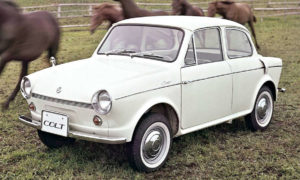
Colt 600
―― Orthodox design at beginning
At the same time, in 1961, the design function of the Shin Mitsubishi Heavy Industries was promoted from the Design subsection of the Equipment Engineering section to the Design section of the Engineering Department, with Masataka Nimura, section chief, and Yoshio Tsubota, the general manager of the Engineering Department, took charge of the design work. The exterior design team was headed by Tsutomu Ieda, with Munetaro Shigehiro and Ryu Kaibuchi as staff designers. I was basically in charge of interiors but was also involved in exteriors as needed.
The design of the Colt 1000 proceeded as the staff materialized the basic image that Tsubota and Nimura had in mind. Their aim was steady and conservative, and the resulting clay model was a straightforward summary of the common design of the time, with bullet-shaped front and tail fins. In other words, it was almost a larger version of the Colt 600, but with four doors.

Scale models in early stage
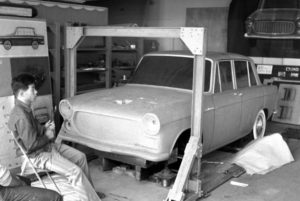
―― Overnight change
However, as Ieda and us proceeded with the design under Nimura’s direction, we gradually began to wonder if this was the right way to go. This was because according to information from the Italian car magazine “Style Auto”, which we subscribed to Shimada Yosho in Aoyama, Tokyo, We felt that the flat deck style was becoming a major design trend around the world. The flat deck style was a design treatment with a flat hood and front grille, which gives a clean modern feel and was a new design that sets itself apart from the past.
We had several times specifically suggested that we should incorporate a flat deck style, but regrettably, our bosses would not listen to us. In the meantime, prototypes had already been built based on the design then underway, and the project was progressing steadily. However, we felt that by the time this car appeared, the design had already become outdated, and we became dissatisfied with our bosses with a strong sense of urgency. By this time, the day was approaching when we were to show the clay model to Tomio Kubo, Director-General of the Automotive Business Division, for approval of the design. So we made up our minds and secretly studied a flat deck style design without telling Nimura and Tsubota. I drew the sketches and worked with Ieda for about a week to brush up the design. Then, the night before the general manager came from the Tokyo head office, we changed the clay model at once. Of course, Nimura and Tsubota were stunned when they saw the model the next morning, but we were able to get Kubo’s approval for the drastically changed design.
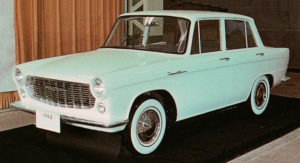
Prototype in early stage
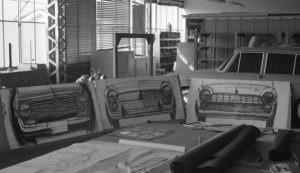
Design study sketches for front end
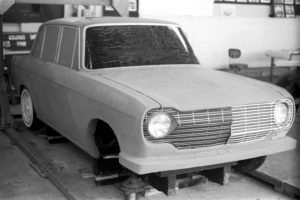
Clay model rebuilt in one night
―― Looking back
I don’t remember what kind of exchange took place between Nimura and Ieda after that, but I think the situation became awkward. At that time, the Design section was like a battlefield, and we young staff were filled with the feeling that we had to create a good design whatever it takes, and it was true that we ran ahead with our youth. Looking back now, with both our superiors and subordinates still lacking in wisdom and experience in car design, I think such a clash was unavoidable.
After the design was finalized, Hans Bretzner, who was designing the Debonair in another studio, drew a beautiful sketch of the Colt 1000 and presented it to us. It was like he was congratulating us on our design, which made us very happy.
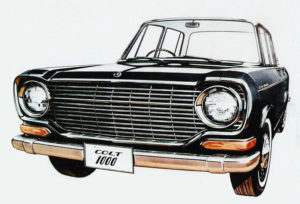
Sketch gifted by Bretzner
Editor’s summary of Ryuzo Ito’s talk December 2021
Memories of Colt 1000
Shinichi Mitsuhashi
―― My Start at Mitsubishi
I joined the Shin Mitsubishi Heavy Industries in 1960, and at the beginning of that period, I was an apprentice. It was a period where we did on-the-job training at the factory and also worked on a paper for promotion from an apprentice to a full-time employee. My promotion paper was titled “Variable Driving Posture Study Device. To tell the truth, Kouya Watabe, who was my supervisor, drew most of the drawings for this paper, and I relied entirely on him. Watabe was a theoretician and a person who thought things scientifically. At the same time, he was easy to talk to even though he was my senior, and he was the person I respected the most in the workplace.
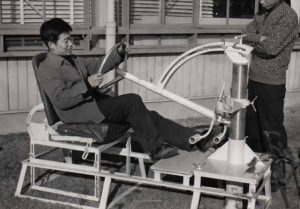
Variable Driving Posture Study Device
―― Steering Wheel Design without horn ring
After finishing my promotion paper successfully, I was assigned to work on the general interior design of the Colt 1000. I was imitating Hans Bretzner by drawing full-size sketches in chalk on Kent paper, but the schedule was pressing and I was instructed by Watabe to start work on the steering wheel design immediately. When I checked the brochures of American cars, I found that most passenger cars had horn rings, which seemed to be a common practice. However, I thought that if the steering wheel was deep and conical like American cars, a horn ring would be essential, but if it was not, it would not be necessary. Place a softly shaped pad in the center, and press the pad itself to sound the horn. The pad should be large enough to give the impression of safety. I thought that the operability would not be a problem, that it would lead to cost reduction, and above all, the simple design without superfluous things would be fresh.
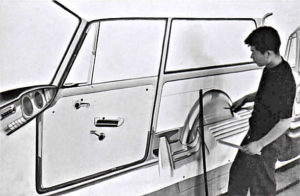
Writer working on full-size interior rendering
The Colt 1000 was launched much later than the Datsun Bluebird, Toyopet Corona, and the Hino Contessa that followed. Other companies were always trying new things, and I felt that Mitsubishi would have to be overly ambitious in its design to catch up. However, General Manager Tsubota, who was in charge of judging the design, opposed the use of the progressive flat deck style in the exterior design and stuck to the conventional design, considered by my seniors to be conservative. To be honest, I was anxious to see how Tsubota would take my design since it had always been the usual practice to put a chrome horn ring on the steering wheel to make it look more prestigious, and eliminating it would give the impression that there was nothing there that should be there.
―― Lose myself unexpectedly
At the department’s interior design review, Tsubota was in a foul mood when he saw my steering wheel model on the desk. “It looks kind of weird,” he said. “It’s unbalanced, and first of all, why doesn’t it have a horn ring? I said bluntly, “This is something new. Horn rings are already old.” The people around me fell silent and the atmosphere became very awkward. Tsubota said, ” Put on the horn ring! I guess you have to start over again.”, pushing the model back toward me. At that moment, I completely lost myself. I picked up the model, swung it upward, and slammed it down on the desk. Everyone in the room was stunned, and I ran out of the room, my head spinning.
Later, I was scolded a lot by my seniors. Ieda, who used to say, “A designer should insist on one’s opinion if one thinks it is correct. You should not lose.” also scolded me, saying, “That was not right. Go apologize to him right away.” I couldn’t quite figure out myself, but at the same time, I was ashamed and frustrated with myself. In the end, through Watabe’s arrangement, Ryuzo Ito, a senior staff member, put together the design with a horn ring in place of me, and he did a solid job.
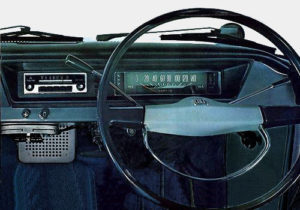
―― Utmost design we can do
When the Colt 1000 was launched in 1963, a few months later the 2nd gen. Blue Bird and the 2nd gen. Prince Skyline were launched, both in the so-called flat deck style. Furthermore, the 3rd gen. Toyopet Corona, released the following year, was not only in the flat deck style but also an innovative design that was one step ahead of its time, which impressed me greatly. On the other hand, the design of the Colt 1000, although it was in step with the times, was conservative and rigid. In designing this car, Tsubota and Nimura were certainly conservative. Looking back on it now, however, I realize that the Mitsubishi 500 was not well received, so the two of them felt they should somehow bring the design up to par with the rest of the world, and they had to be on the safe side. And we, the staff, were just barely able to put the design together to this point, and we were still lacking ability.
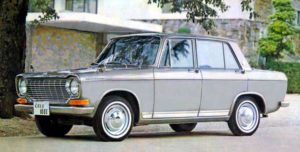

Toyopet Corona (left) Nissan Blue Bird (right) Photo courtesy of Toyota Automobile Museum
―― Small Footprint
As a lover of motor racing, Ito and I went to Suzuka in 1964 to watch the second All-Japan Automobile Grand Prix. The previous year, Toyota’s Crown, Corona, and Publica had won their class championships in the first grand prix, and the sales campaign had led to a huge increase in sales. Therefore, all the companies, including Mitsubishi, participated in this year’s event as works teams on a full scale. Notably, Prince even produced 100 units of a special edition Skyline GT for this race. Mitsubishi’s Colt 1000 competed with the Hino Contessa in the TIII class of the touring car category, winning the race and sweeping the top four places. I remember feeling very proud. Thus, although the Colt 1000 was an earnest and modest car, it was able to leave a small footprint on history.
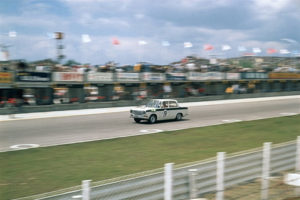
―― Unexpected Letter
I learned a lot from Watabe in the interior design of the Colt 1000. Although Watabe was not that much older than me, he was not only skilled in practical work but also had a firm idea of what a car and its design should be like, and I wanted to follow his example. A few years later, the company granted me an opportunity to study at a design school in the United States. I was living an exciting life in California, with new things happening every day when I received a letter from Watabe. As I read the letter, I was surprised to learn that Watabe and Ieda had decided to quit their jobs and set up their own design office in Nagoya. The letter said, “I have no choice but to ask you to take care of the rest. … Please study hard in the U.S.” It was a pity because I had been a great help and friend to both of them, but each person has his or her own path, and I had no choice but to think that I would study hard to make up for them both.
Editor’s summary of Shinichi Mitsuhashi’s talk, December 2021